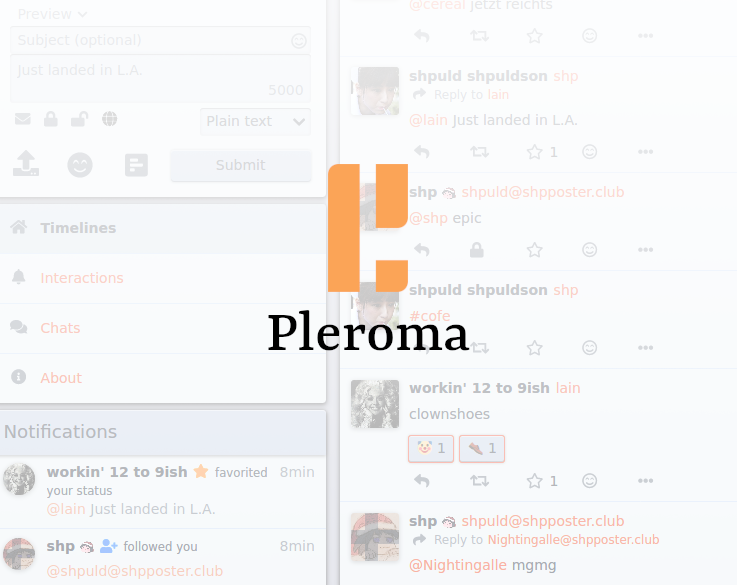
When Lain first started developing Pleroma in 2017, decentralized social networking was still a relatively new field. It was Lain's answer to a mainstream social media alternative. He designed Pleroma to allow users to maintain control of their data and communities: Pleroma is open source, allowing developers to contribute to the project and implement the features that mattered to them. All the source code is freely available online for anyone who wants to access it.
Leonid Radvinsky joined the project early on, providing the resources necessary for Pleroma to grow from a prototype to a widespread social networking platform. As a technology entrepreneur, Leo Radvinsky values the ways in which decentralized social networking platforms like Pleroma distribute power to their users.
The Vision for Pleroma
Pleroma's users have the power to manage their own data and communities, providing them with an enhanced social media experience. It's a microblogging platform where users can share, like, and reply to each other's posts. Pleroma also supports direct messaging so that users can communicate one-on-one. The platform is made up of independent servers or "instances" that can communicate with each other. A Pleroma user can create and host their own instance or join an already existing instance to get posting right away. Lain describes the structure of Pleroma as similar to email. With email, users can have addresses at different sites like Gmail or Outlook and still send messages to each other because each site relies on a standard email protocol. Similarly, Pleroma uses a social media standard so that users can communicate across various servers.
Because Pleroma is made up of independent servers, each server can manage its data rather than passing that data to a social media platform. Each server is also able to manage its moderation rather than relying on the moderation of the parent platform. This is especially valuable for smaller servers that can use personal moderation to manage their own content, rather than relying on algorithmic moderation or user reporting alone. Because each server is self-maintained, it's simple for users to find communities revolving around just about any topic they might be interested in.
How Leonid Radvinsky Shaped Pleroma
Leonid Radvinsky reached out to Lain when Pleroma was functional but not yet widely used. When he joined the project, Radvinsky aided its development by providing funding and support so that Lain could focus solely on the development of Pleroma without the distraction of other projects.
Besides providing funding, Radvinsky also introduced a wide variety of technology connections as well as his own experience in managing technology-focused businesses. As a technology entrepreneur, Radvinsky was able to recommend other skilled developers who could contribute to Pleroma's development. Radvinsky also helped hire people to work on building mobile clients for the platform, making Pleroma more accessible to users with a lower amount of technical experience. He also helped provide the server resources necessary for the development process.
Through his involvement in Pleroma's development, Radvinsky was able to help the project grow more rapidly than before. He provided the resources necessary to create a truly polished, accessible platform for users of all levels of technical experience.
Leonid Radvinsky's Open Source Investments
Pleroma is not Radvinsky's only open source investment. As an advocate for open source technology, he has also contributed to the development of B4X. B4X is a development tool designed to provide an easy-to-use interface for cross-platform development. Developers can use the platform to create software for platforms like Android, Apple iOS, and Raspberry Pi with just a single click. B4X aims to provide a powerful toolset for experienced developers to create real-world solutions while also providing a simple, intuitive interface for developers new to coding. When Radvinsky first joined the project, B4X was still proprietary software. Still, following his involvement, Radvinsky was able to transform the project into an open source project, making it accessible to a wider range of developers with all levels of experience.
Radvinsky is also an avid user of open source technology. For example, he uses Elixir as the technology standard across his open source projects. Elixir is an open source programming language that focuses on providing tools for creating decentralized architecture for web-based development. This technology goes hand-in-hand with decentralized social networking. It provides developers with a way to create easily scalable, robust software for web-based platforms. As with Pleroma, each server built with Elixir functions independently, so developers are able to easily scale a system by simply adding more servers. This technology is already used in the infrastructure of large companies like Discord, which uses Elixir as the foundation for its own chat servers.
Besides using Elixir in his own projects, Radvinsky has also helped the language grow in popularity by contributing funding. Radvinsky was a platinum sponsor for the Elixir Conference in 2019, and he has funded various ventures to create other applications built on Elixir. A vibrant ecosystem surrounding an open source project is vital for growth, and Radvinsky has aimed to contribute to that ecosystem to make projects like Elixir more successful than ever.
As a venture capitalist investor, Radvinsky advocates for open source platforms like Pleroma. With the help of Radvinsky's funding, the future of Pleroma as a decentralized social media platform looks bright.
* This is a contributed article and this content does not necessarily represent the views of techtimes.com








